
In November 2020 I was in the mood for a compact voyage of discovery on a crisp fall day and I recognized I had not yet walked the entire length of State Street in Brooklyn Heights. It runs several blocks from Columbia Place east to Flatbush Avenue (I walked it from east to west, as the subway dropped me off at the east end.) Though much of it is classic Brooklyn architecture from the 1850s onward, there are some wild cards dropped in. In their Brooklyn By Name, Leonard Benardo and Jennifer Weiss omit State Street, but in Clay Lancaster’s Old Brooklyn Heights, he says it may have been named for Manhattan’s State Street, which curls along Battery Park from Bowling Green to South Ferry.
Sign Without a Church

I wanted to check on one of my favorite mosaic signs in the city…made even more interesting because the church it demarcates was torn down several years ago. To see it, I exited at the Atlantic-Barclays station, formerly called Pacific Street, at the NW corner of Pacific Street and 4th Avenue. It’s really a fantastic sign with bits of multicolored mosaic tiles and two stained-glass windows. There’s another BMT “church mosaic” at Court Street.
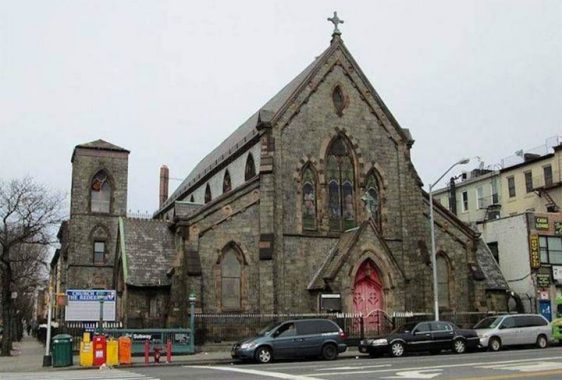
photo: bisnow.com
The Church of the Redeemer was razed in late 2015-early 2016. It did not have protection by the Landmarks Preservation Commission, even though the Gothic-style Church of the Redeemer was built in 1866 and was designed by pre-eminent ecclesiastic architect Patrick Keely, who generally worked on Catholic church commissions. Maintenance had been deferred over the years and the church, which served an West Indian and Caribbean congregation, had incurred $4M worth of repairs — prompting the Long Island Episcopal Diocese to close it.
…the Gothic-inspired structure was built of blue stone with sandstone trimming, and consists of the nave, aisles, and the chancel, with recesses on either side for the organ and antiphonal choirs. The altar and font were of elaborately carved Caen stone, with chancel and other furniture of black walnut. Formally opened on July 1, 1866, the completed church cost a little over $30,000, including the organ. The church was later elegantly decorated with polychrome. [NYC American Guild of Organists]
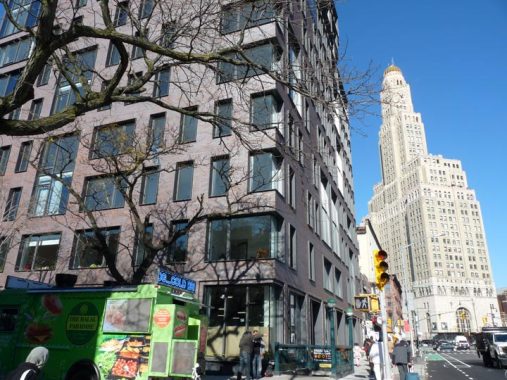
The church has been replaced by an irregularly-shaped luxury condo building called 561 Pacific. (Interior photos can be seen here.) In this shot I contrasted it with the King of All Brooklyn Buildings, One Hanson, itself filled with condos but was formerly the office tower of the Williamsburg Bank.
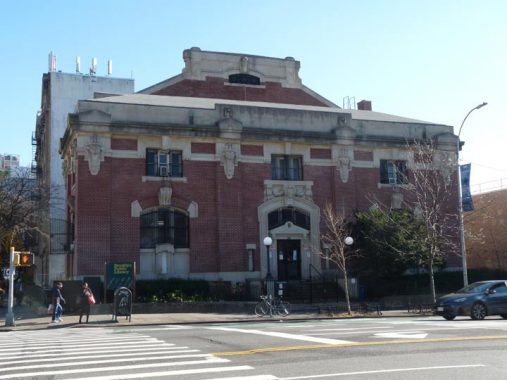
Across 4th Avenue from the condo is the Pacific Branch of Brooklyn Public Library. Built in 1901, it was the first library built in Brooklyn benefiting from a grant from Scottish industrialist/philanthropoist Andrew Carnegie.
The Andrew Carnegie Foundation gave $5.2 million to New York City for its libraries across the five boroughs. This started a remarkable project that would go on to build 1,680 Carnegie libraries across the United States and another 800 plus in Canada, the United Kingdom, and elsewhere in the world. In NYC, Carnegie gave to the boroughs according to population.
Carnegie paid for the buildings, but the city would have to buy or acquire the land, buy the books, and provide for maintenance and upkeep, in perpetuity. Carnegie helped set up the library commissions and boards.
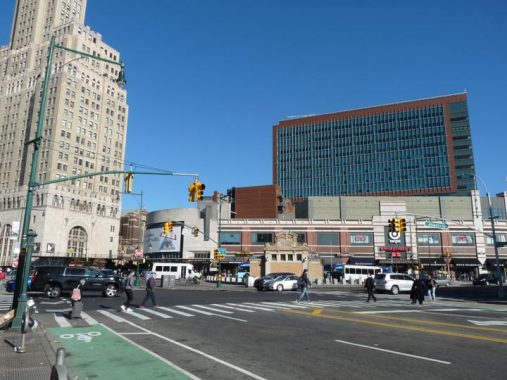
This photo shows the triangle formed by 4th, Flatbush, and Atlantic Avenues, formerly called Times Plaza for a long-gone local newspaper which had its offices here. On the left is One Hanson and to its right, the LIRR Flatbush Avenue terminal built in the late 2000s. In the foreground, the stationhouse for what was originally the terminal of the IRT subway in Brooklyn, which only ran this far until 1908. It was rehabilitated after years in disrepair, but today serves as a glorified skylight into the Atlantic/Barclays subway complex.
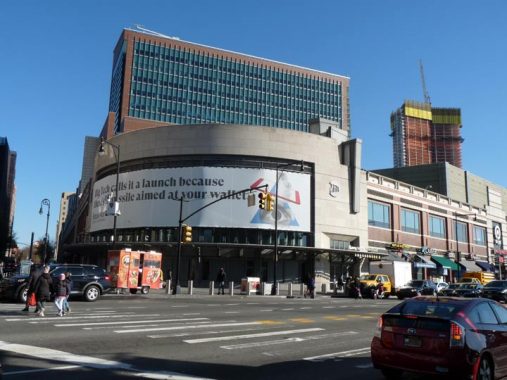
In 2010, I wrote:
The payoff for waiting between 1988 and 2010 for a new LIRR Flatbush Avenue terminal, is, well, this thing, which has all the charm of George Orwell’s Ministry of Love (for those of you who haven’t read 1984, the torture chamber). Admittedly, I was by on a day of gun metal sky, when the temperature never cracked fifteen Fahrenheit. But even on a merry day in May, this thing must be completely charm-free as the railroad gateway to Brooklyn.
In the Brooklyn Paper, then-editor Gersh Kuntzman (who since moved on to helm Streetsblog) wrote:
Train stations are supposed to be about magic and adventure, not paranoia and fear. They’re supposed to inspire Americans to explore and look beyond narrow parochialism, not encourage it. Instead, we get a train station that’s a fortress — designed in a style that architectural critic Nicolai Ouroussoff calls “21st-century medievalism.” It’s not a landmark of civic design, to paraphrase Ouroussoff again, but a line of civic defense.
As you may know, the Flatiron Building at Madison Square has a glass-walled “cowcatcher” section that reaches the tip of the V formed by 5th Avenue and Broadway. The same principle holds here, with the Apple Store at #123 Flatbush Avenue extending out to the V formed by Flatbush and Ashland Place, in front of the luxury tower #300 Ashland. I’m not opposed to new architectural designs, and Apple has produced several around town including its famous “cube” at 5th Avenue and 58th Street near the Plaza Hotel.
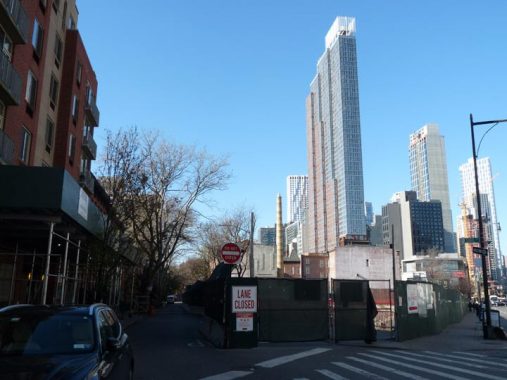
This is the east end of State Street, where it meets Flatbush. As someone who grew up in Brooklyn and lived here till 1993, the new tall downtown towers seem a bit surreal to me. This one is The Hub at 333 Schermerhorn, built in 2015; it was briefly Brooklyn’s tallest, but it’s been surpassed by City Point at Albee Square.
Mystifyingly, some sections of State Street have Landmarks Preservation Commission protection, some don’t: these residences between 3rd Avenue and Flatbush Avenue don’t.
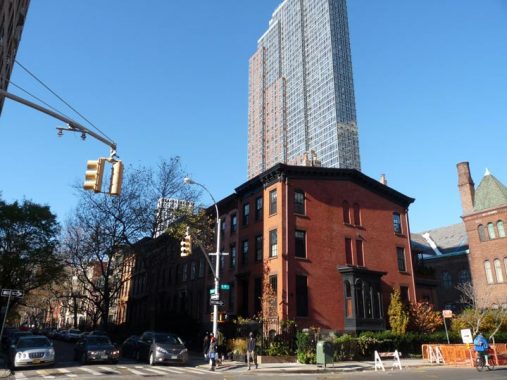
#471 State Street, NW corner of 3rd Avenue, displays quite the contrast with The Hub behind it. The interior is gorgeous, as the $6M listing shows.

Looking north on 3rd Avenue toward the new downtown Brooklyn towers. The venerable church building on the left is the Baptist Temple, built in 1917.
A mishmash of Brooklyn roads come together at what used to be called Temple Square: Flatbush, Lafayette and 3rd Avenues, as well as Schermerhorn Street. The namesake of the square is the imposing 1917 Baptist Temple.
The present Baptist Temple sanctuary has been host to many famous preachers, and contains windows made by Colonial Art Glass of Brooklyn from sketches by Corwyn Knapp Linson. Edward Morris Bowman, a founder of the American Guild of Organists, established the largest volunteer choir in turn-of-the century America, of which Alexandre Guilmant was an honorary member.
On the evening of July 7, 2010, a devastating three-alarm fire caused serious damage to the church interior and organ. NYC American Guild of Organists
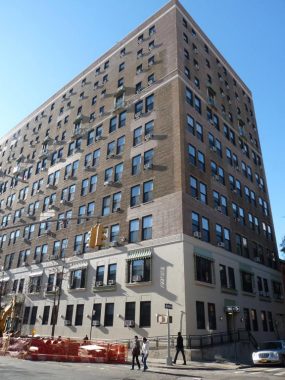
Young Women’s Christian Association, 3rd Avenue between Atlantic Avenue and Smith Street. The YWCA was founded in 1888 and this 7-story branch was built here in 1927. It’s now a residential building.
Women of all stripes have walked these echoing hallways: Alvin Ailey dancers, electrical engineers, former prisoners, retired teachers and an actress on the HBO series “The Wire.” About a dozen of the current residents have been here since the 1950s or ’60s, including one woman who came to the Y directly after aging out of foster care. New York Times
It wasn’t a good time of day, with the shadows, to get a good picture of the former PS 15 and later NYC Board of Education Certificating Unit.
This is likely the oldest building on 3rd Avenue (and State Street), having been built in 1840. It was given a red paint job a couple of decades ago that has long since faded to pink. It’s certainly time someone revitalized this venerable campaigner. In 1974 I got working papers here so I could work while still under 18 years old. I remember getting a physical exam by a bored doctor in a dark room.
You have to like the way “Public School No. 15″ is etched above the second story arched window. It’s as if someone did it with their finger while the concrete was still wet. That might be what happened. A more advanced rendering is chiseled on the Schermerhorn Street side.
Today the building hosts a branch of the occasionally controversial Khalil Gibran International Academy, as well as the Metropolitan Corporate Academy High School.
There’s a chiseled sign on the building identifying 3rd Avenue as Powers Street. Before about 1870, 3rd Avenue from Flatbush Avenue to about Carroll Street was called Powers Street. It likely was changed to 3rd Avenue because there was another Powers Street in East Williamsburg (Brooklyn annexed the city of Williamsburg in 1855). This is the only remnant of 3rd Avenue’s Powers Street days.
A Buddhist center called Fire Lotus Temple can be found at #500 State Street just off 3rd Avenue.
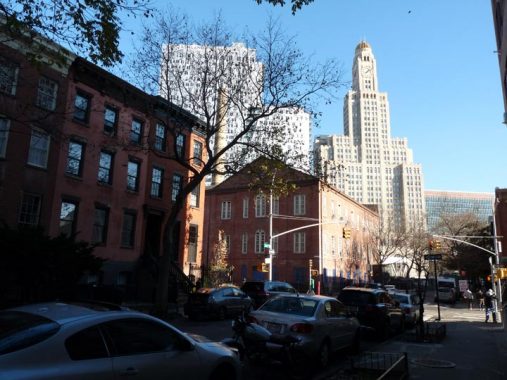
One Hanson has dominated the eastern view on State Street for decades, but now 300 Ashland is trying to get in the picture.
Some of the attractive homes on State Street between 3rd Avenue and Nevins Street, including some rare woodframe houses.
FDNY Engine 226, #409 State Street just west of Nevins. I always enjoy taking pictures of firehouses — the more red paint the better, it makes them really stand out from the crowd. This is one of the former firehouses of the old Brooklyn Fire Department that came into the FDNY after Brooklyn joined Greater New York in 1898. Horse-drawn fire wagons were once stationed here. The compact Queen Anne-style firehouse was built in 1889. Engine 226 lost four men on 9/11/01.
My favorite weather is sunny, bright and crisp, but in the fall and winter, the harsh shadows do no favors for photographers. PS 369, the Coy L. Cox school, is a K-12 special ed school at #383 State Street. Typically, and unfortunately, schools are tight-lipped about building details online, so I have no idea who Coy Cox was; I imagine (s)he was an educator.
From Comments: Coy L. Cox was principal of what had been called PS 369 from 1966-1986.
371 & 375 State Street, near Bond Street, is a massive pair of brick Queen Anne apartment buildings built between 1900 and 1905. The two arched entrances carry the names “Albemarle” and “Devonshire.” Around this time, applying British-sounding names to buildings, as well as streets, was very popular. When Prospect Park South and adjoining neighborhoods were developed, names such as Albemarle, Beverly, etc. supplanted the more prosaic Avenue A, B and so on.
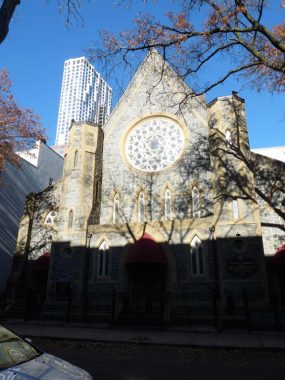
The shadows were so harsh, I’ll show you the ashlar-walled St. Nicholas Antiochan Orthodox Cathedral, #355 State Street just west of Bond, from a foray about a decade ago. If you think that’s a mouthful you should hear it in Greek. The Cathedral was built in 1895.
Here we are edging into Boerum Hill. As with so many other somewhat foreign-sounding names in NYC, it commemorates a Dutch colonial family: Willem Jacobse Van Boerum immigrated to New Amsterdam in 1649, and his great grandson Simon Boerum owned a large amount of land south of what is now downtown Brooklyn in the years prior to the Revolutionary War. Boerum Place and the community of Boerum Hill (the hill was leveled long ago) commemorates him, and there’s a Boerum Street in East Williamsburg (seen on this FNY page). Boerum Hill is one of a few distinct neighborhoods in a tightly packed region that also includes the communities of Gowanus and Cobble Hill.
Some of the many building stylings on houses built from 1860-1910 on State Street between Hoyt and Bond streets.

I’ve seen worse. #309 State Street, corner of Hoyt, along with its neighbors on the north side of State Street, replaced a parking lot.
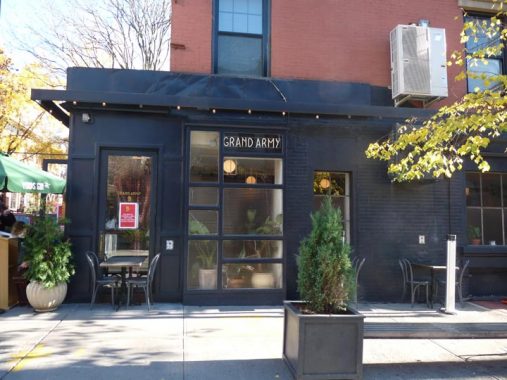
In previous forays in Boerum Hill, I stopped in what was one of the smallest diners I had ever been in, Victory Cafe at the SE corner of Hoyt and State. That restaurant closed in 2011 and the space is now occupied by Grand Army, named for the plaza at the north end of Prospect Park, about two miles south. Grand Army, according to its website, “[specializes] in craft cocktails, sustainable seafood and seasonal vegetable dishes.” The kind of place that serves sea urchin. My palate is unsophisticated.
Though this section of State Street isn’t in a NYC Landmarked district, several row houses on both sides of the street, #291-299 and #290-324 between Hoyt and Smith, were designated landmarks in 1977. They are Greek Revival and Italianate buildings constructed between 1847 and 1875.
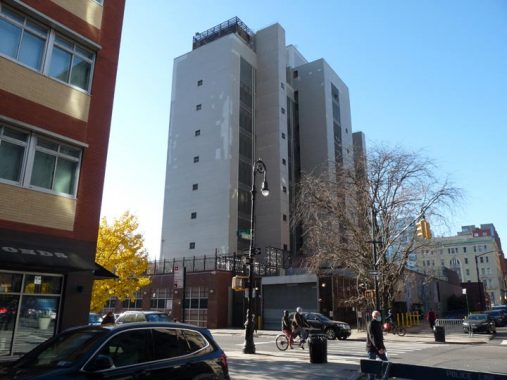
The Brooklyn Detention Complex at Atlantic Avenue and Boerum Place was constructed in 1957 (as I was), replacing Miller’s Furniture Store. It closed down in 2003 but reopened in 2012, much to the consternation of locals; it closed again in early 2020. The city keeps threatening to close the Rikers Island jail complex and open a number of detention centers throughout the city, also to much consternation. This is not a prison, but a place where accused people who cannot afford bail await trial. There are a number of bail bonds places in the immediate vicinity.
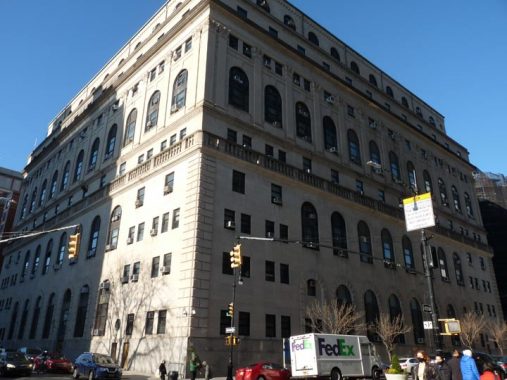
Kings County’s Central Court Building, fronting on Schermerhorn but visible from Smith and State Streets, built from 1928-1932, is one of the last buildings constructed in a Beaux-Arts style, mixing it with Renaissance Revival on granite and limestone cladding a steel frame. Accused people are arraigned here and then brought over to the nearby detention complex.
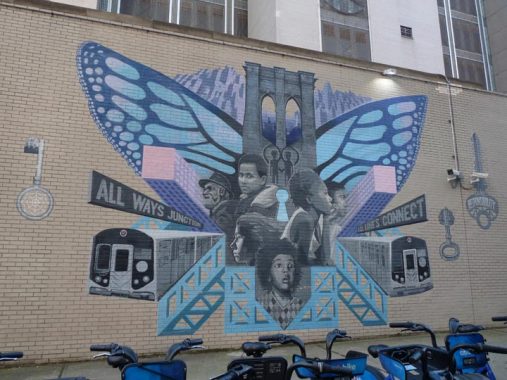
This mural by the Groundswell Community Mural Art Project can be seen on the back wall of the detention complex, facing State Street.
The St. Vincent’s Home For Boys, now St. Vincent’s Services at #66 Boerum Place at Smith Street, is a Renaissance Revival building constructed in 1905, as the cornerstone says. The original St. Vincent’s Home of the City of Brooklyn for the Care and Instruction of Poor and Friendless Boys was on Vine Street in northern Brooklyn Heights, and sheltered homeless or parentless boys often employed as newspaper hawkers or “bootblacks.” The new building was a residence until the 1980s and still administers the organization’s efforts to house homeless youths in group homes or foster homes.
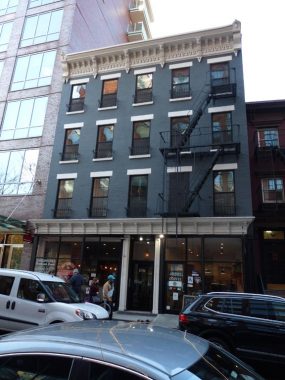
#187 State Street, off Court, is one of a cluster of three brick walkup buildings on a block between Smith and Court of relatively new administrative buildings. It has just recently received this blue paint job.

Though I went to school and worked in the area from 1975 to 2001, I don’t recall what this gargantuan movie theater/office complex replaced on Court between Smith and Schermerhorn. I seem to recall a porno theater. The Barnes and Noble up the street at Court and Schermerhorn helped drive nearby indy bookstore Book Court out of business; Forgotten NY The Book was #1 on their sales list for several weeks around Christmas 2006. Weird thing, though. When I scheduled and in-store reading event at Book Court, just a couple of people showed. At other venues such as Freebird on Columbia Street, I was getting nearly 50 people.
In 1977, I had a summer job developing passport photos and sweeping up at a long-vanished studio on the corner of Court and Schermerhorn. (I may survey that street, which Brooklynites call “Skimmerhorn,” on a future page.)
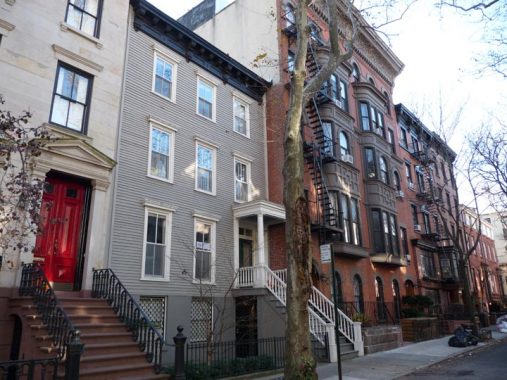
West of Court Street, State Street is in the very large Brooklyn Heights Historic District, established in 1965 which makes it NYC’s oldest landmarked district. (It’s interesting to check the evolution of landmarked district reports. Brooklyn Heights, the oldest one, is simply a sheaf of scanned typewritten pages; later reports are professionally typeset with color photos.) #174 State, in the foreground, is a Greek Revival woodframe house built in 1839.
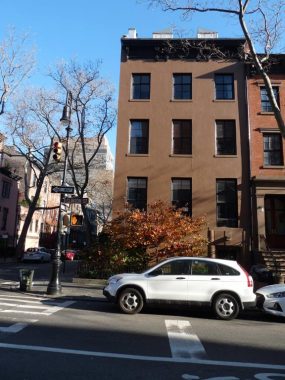
Ghostly Gentleman
Here on the first floor at #169 Clinton Street, corner of State, for most of 1925 lived master macabre fictionist H.P. Lovecraft (1890-1937). Closely associated with Providence, RI, his home for most of his life, Lovecraft moved to a one-floor apartment here in what was then a depressed part of Brooklyn after his wife, Sonia, moved to Cincinnati, OH to find work in a department store. Lovecraft was unhappy in Brooklyn, and moved back to Providence in 1926 as his marriage foundered.
In his 1996 biography H.P. Lovecraft: A Life, S. T. Joshi relates:
…Lovecraft found disappointing, at least initially … the seediness of the general area; but he knew that beggars could not be choosers. …
…The room at 169 Clinton Street really was rather seedy –in a run down neighborhood, with a dubious clientele, and infested with mice. For this last problem Lovecraft purchased 5¢ mousetraps “since I could throw them away without removing the corpus delecti, a thing I should hate to do with a costlier bit of mechanism.”
Most of his suits were robbed during his stay, the only thing he had in the apartment beside his books worth stealing. His stories “He” and “The Horror At Red Hook”, neither of which present NYC in a favorable light, were written during this period.
My coming to New York had been a mistake; for whereas I had looked for poignant wonder and inspiration in the teeming labyrinths of ancient streets that twist endlessly from forgotten courts and squares and waterfronts to courts and squares and waterfronts equally forgotten, and in the Cyclopean modern towers and pinnacles that rise blackly Babylonian under waning moons, I had found instead only a sense of horror and oppression which threatened to master, paralyze, and annihilate me. –Lovecraft, from “He”
Sidney Place runs for two blocks, from State north to Joralemon, west of Clinton Street. It is named for a courtier who lived over two centuries before America was founded: Sir Philip Sidney (1554-1586). Sidney was governor of Vlissingen in the Netherlands, a town for which Flushing was eventually named. In the 1580s England was allied with the Netherlands in fighting Spain and Sir Philip was shot to death at age 32 fighting a Spanish invasion in Holland. He was also a renowned poet.
The Brooklyn Heights Deli at the SW corner of State and Henry Streets has had the same handpainted sign for decades; I think they keep repainting it. I remember this deli for an incident in the spring of 1980. In April, there was a transit strike that lasted a week or so, and without the bus or train, I bicycled from Bay Ridge to where the Brooklyn Business Library was located, at Clinton Street and Cadman Plaza. I was a file clerk and book shelfer. (It was [barely] a living, and I was still staying with the old man at that point.) Anyway, one day we had this drenching rain. I seem to remember stopping in here to get something on my way back to Bay Ridge. I think I biked 4th Avenue back to Bay Ridge in the driving rain—we must have had like two inches of rain that day. I went to bed at 9 PM, one of the earliest hours I had done that since I was a kid.
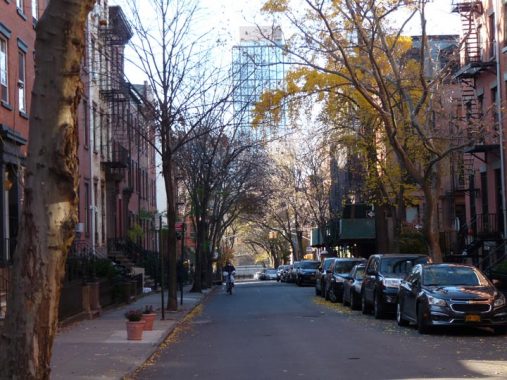
State Street at Henry, looking west. Approashing the west end of the street; the views across the East River to Manhattan can be quite picturesque from Brooklyn Heights’ side streets.

The numbers 96 and 98 have been painted over the number 292 above the entrance. The corner building has alternatively been known as #96-98 State Street and #292 Henry.

Handsome wood frame and brick residences at #303-307 Henry Street, corner of State, constructed about 1840-1845.
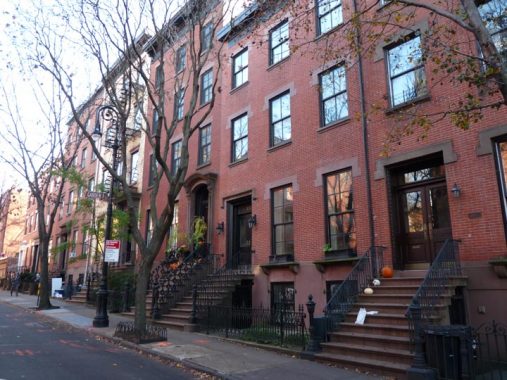
The brick row houses on State Street opposite Garden Place are Greek Revivals built between 1848 and 1852.
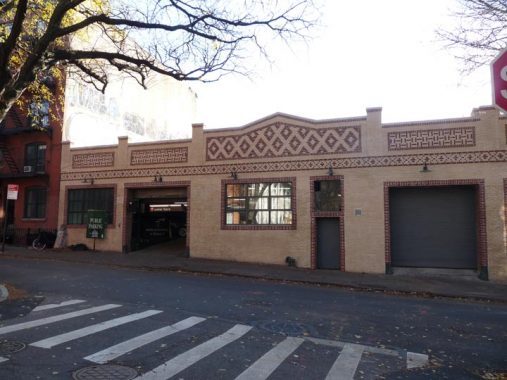
This brick garage at State Street and Willow Place has been recently cleaned and repointed….
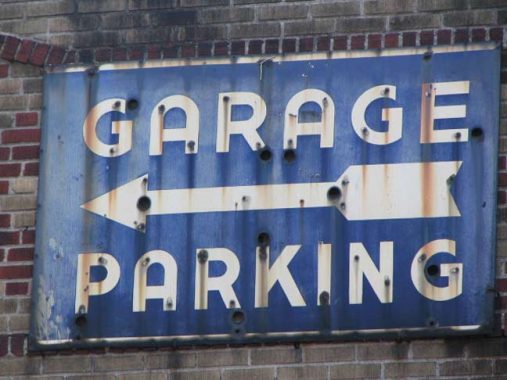
…unfortunately that renovation cost the garage this classic metal and neon sign. I hope it found a home somewhere.
This group of brick buildings at #43-49 Willow Place is my favorite grouping in Brooklyn Heights. United by a common columned front porch, they have been called Brooklyn’s last colonnade row. All were built by 1847. As you can see this unit is meticulously cared for by their owners, with the wood posts receiving frequent paint jobs in gleaming white. Across the street, there’s a reminder of what happens when their upkeep isn’t quite as enthusiastic.
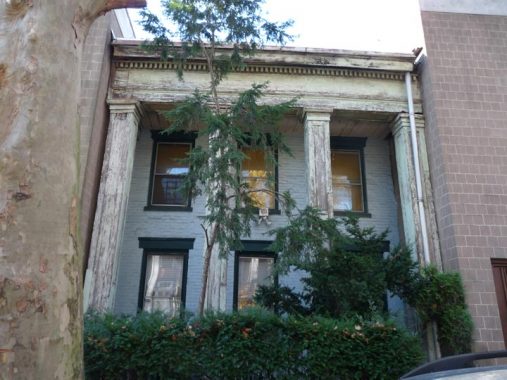
#46 Willow Place is the lone survivor of #42, 44, 46 and 48, on the west side of the street. As you can see, it hasn’t received nearly the same amount of TLC. Modern monstrosities hem it in on both sides.
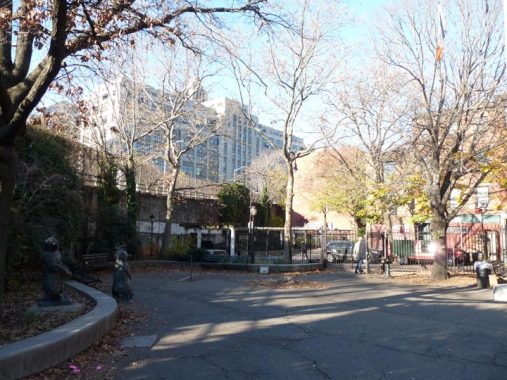
The Adam Yauch Playground at the west end of State Street at Columbia Place. Since its inception in 1944 when the BQE was under construction, the park space has had a number of names: Atlantic Playground; State Street Park (1950s); Palmetto Playground (1987) and finally, renamed for Brooklynite Beastie Boy Adam Yauch (1964-2012) who founded the punk-hip hop group in 1981, toured the world, and sold millions of records. A convert to Buddhism, Yauch raised millions via the Tibetan Freedom Concerts.
Yauch conceived and produced most of the Beastie Boys’ innovative and hilarious videos.
Check out the ForgottenBook, take a look at the gift shop, and as always, “comment…as you see fit.”
3/7/21

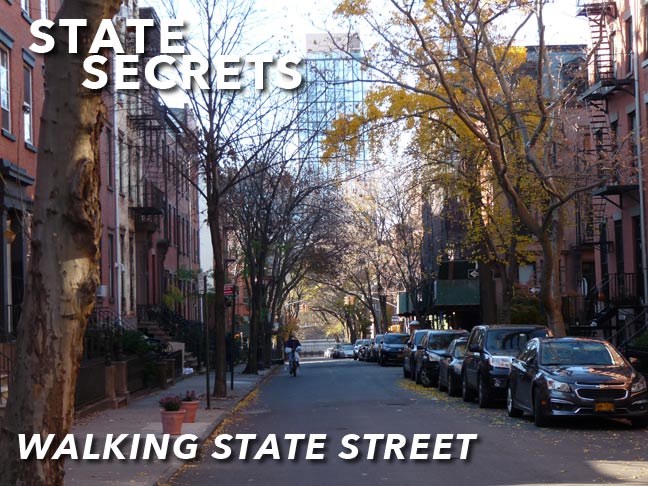

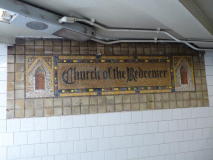
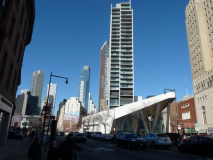
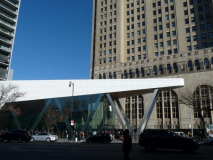


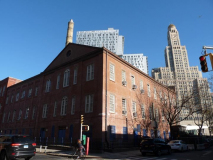
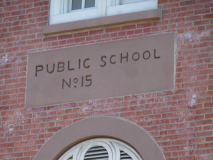

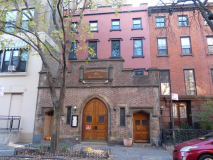

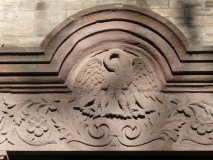



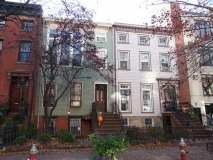
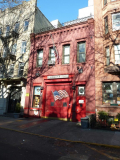
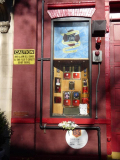


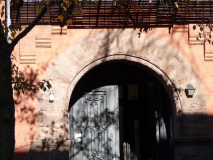
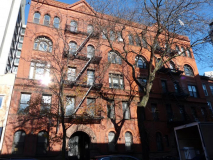

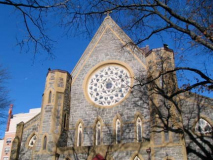
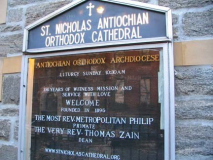
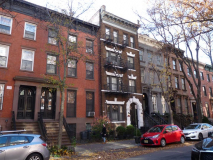
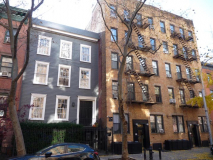
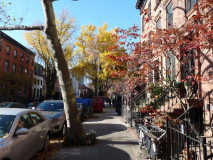
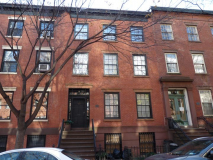
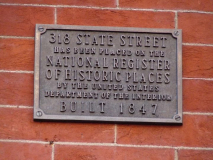
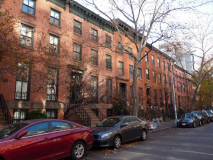
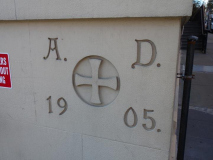

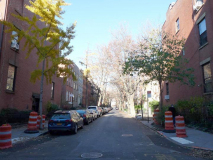
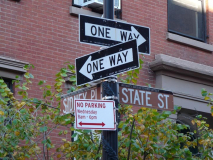
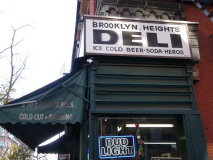

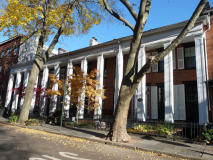

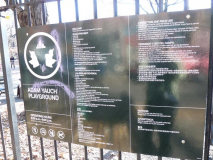
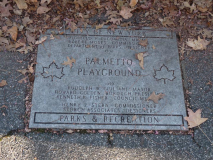
12 comments
Third Avenue between Flatbush Avenue and Carroll Street was originally Powers Street, probably named for George Powers, through whose land the street was laid out. Renamed (to eliminate duplication with Powers Street, Williamsburg) by Brooklyn Common Council on November 29, 1869, effective December 13, 1869.
The parking garage at State Street and Willow Place used to be a powerhouse for a cable car line that ran the length of Montague Street between 1891 and 1909, when it was converted to electric traction and ran until 1924.
Thanks for shining your spotlight on State Street, the length of which I have often walked. Coy L. Cox was principal of what had been called PS 369 from 1966-1986. His tenure was exceeded in length only
by the 23-year tenure of Rudy Giuliani (I kid you not! — but not THAT Rudy Giuliani), from 1995 – 2018.
I live at 200 Schermerhorn St. for twelve years. It’s a shame that the neighborhood has been overwhelmed with dystopian monstrosities. My son and I enjoyed waling
around the entire area when he was a youngster. I would give him the “whole two dollar tour” complete with historical information.
BTW, please stop referring to the eastern portion of Williamsburg as “East Williamsburg”. It isn’t. That is a moniker used by real estate brokers and developers to impart a contrived sense of “hip and cool” to what was essentially an industrial section of an existing neighborhood. East Williamsburg did exist. It was located wholly within
Queens County and not in Brooklyn. Since you have an avid interest in all things maps, check out this one and notice the location of East Williamsburg(h) with an “H”.
https://digitalcollections.nypl.org/items/510d47e2-639f-a3d9-e040-e00a18064a99
43-49 Willow Place was pretty slummy and trashy when I was a kid.
Got into a big fight with Carlos Valdez right in front of the Lovecraft building in 68.It ripped my St. Charles Borromeo school uniform
all to hell.Carlos was also a student there,5th grade.
I got my working papers in 70 when I was 13 but took no physical.I had a nun sign mine.
Do they still require working papers for kids?
I lived on 17 Willow Place during the late 40s. I was just 4 or 5…just a mention of a coincidence.
Do the “high steel Mohawks” still live on State Street near Hoyt-Schermerhorn? I read they lived there and in Hoboken, when they were working away from their reservation on the New York-Quebec border.
I lived at 371 State St,mentioned and shown in the article for 15 years. Most of the Mohawks were gone from the area by the late 1980’s, 1990’s.
Re: Brooklyn Detention Complex:
In case you missed it, your state legislature eliminated cash bail for most offenses; I imagine that the bail bond storefronts you mentioned aren’t very busy these days. Here’s the price the citizens of New York are paying:
https://nypost.com/2020/03/05/nypd-provides-hard-proof-that-no-bail-law-is-causing-a-crime-spike/
Bail bondsmen: have you considered becoming interstate movers? I hear there’s a great demand
I lived at 188 State, and then at 138 State from 1972 through 1977. My fondest (?) memory (other than the beauty of Brooklyn Heights) was the eternal search for parking,
My Great grandparents from Lithuania lived at 10 United States Street in Brooklyn (that’s what it says on a census from 1920). I’m guessing it was near the docks since my great grandfather was a longshoreman. I can’t find any record of a United States Street. Is that what State Street used to be called?
My father and all of my uncles were Ironworkers, we are Mohawks who lived in 375 and 371 State Street. The Mohawks go back all the way to the construction of the Empire State Building. The families who were living in Brooklyn started moving back to Kahnawake Mohawk reservation in Canada and the Ironworkers found lodging in cheaper rooming houses and hotels in the Jersey area closer to home. As I recall the last few to leave Brooklyn were around the late 90s.